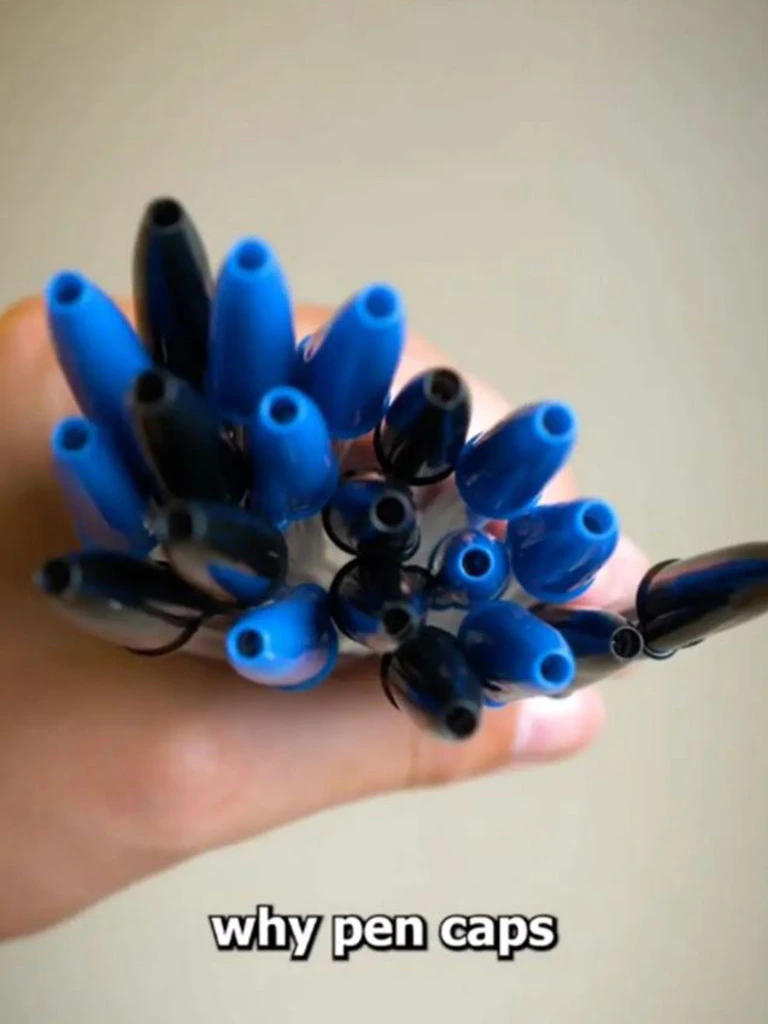We use pens almost every day, toss them in our bags, chew on their ends during deep thought, and click them endlessly out of boredom. But how often do we stop to notice the tiny hole at the top of many pen caps? For most people, probably never. And yet, that small feature isn’t just there for looks — it serves several clever and even life-saving purposes.
Let’s dig into this everyday mystery and uncover why this little hole matters more than you ever imagined.

The Evolution of Pen Cap Design
Before ballpoint pens and gel ink took over desks and classrooms, writing instruments like quills and fountain pens didn’t need caps. But once pens started carrying liquid ink inside a tube, the need to protect the tip — and the ink — became essential. Early pen caps were simple: they kept the ink from drying and the nib from bending or breaking. Over time, though, designers began to innovate.
As pens became mass-produced and more accessible, small design tweaks made a big difference — and that included the hole at the top of the cap.
The Real Reason Pen Caps Have Holes: Safety First
Let’s start with the most important reason: choking prevention.
Pen caps, especially small, detachable ones, are common choking hazards — particularly for kids (and let’s be honest, also for adults who absentmindedly chew on them). The hole at the top of the cap is actually a safety feature.
If someone accidentally swallows a pen cap and it gets stuck in their airway, the hole allows air to pass through — just enough to give them a chance to breathe while help arrives. It may not sound like much, but that small opening can be the difference between a scary moment and a life-threatening emergency.
In fact, in the early 1990s, safety regulators around the world began encouraging — even requiring — pen manufacturers to include this feature. Bic, for example, made this change a long time ago as part of their commitment to consumer safety.
Video: The REAL Reason Pen Caps Have Small Holes 🤔
Airflow and Pressure Balance: How the Hole Keeps Pens From Leaking
Beyond safety, the hole plays another important role you’ve probably never considered: pressure equalization.
When you cap a pen and the air inside gets sealed off, changes in temperature or altitude can cause pressure to build up. That internal pressure could make the ink behave badly — like leaking, bubbling, or drying out.
The hole at the top allows air to circulate gently, preventing vacuum pressure and helping maintain consistent ink flow. In other words, it quietly keeps your pen from exploding in your bag or going dry halfway through your grocery list.
Saving Plastic and Streamlining Production
Believe it or not, that little hole also has a practical upside for pen manufacturers. Including a hole can:
- Use less plastic, reducing waste and cost
- Speed up the injection molding process, because the air can escape the mold more evenly
- Make the cap easier to remove, thanks to improved airflow and pressure release
It’s a rare win-win situation where design, function, and efficiency come together — all because of a hole the size of a pinhead.

A Design Signature That Goes Beyond Function
While the hole is primarily a safety and engineering feature, some companies also treat it as a design trademark. Think of Bic’s classic blue pens — that tiny hole isn’t just smart design; it’s part of the brand’s identity.
Some pen makers lean into this idea, turning the hole into a visual cue that gives their product a distinctive look. Whether it’s used for branding, aesthetic balance, or functionality, the message is the same: this design choice is no accident.
Why Most People Never Notice It
Here’s the kicker — most folks will go their entire lives without knowing any of this. We’re so used to everyday objects that we rarely stop to ask why they’re made a certain way. And when we do, the answers often reveal a lot more thought went into that object than we realized.
Some people think the hole is just decorative. Others guess it’s for ventilation. And while those guesses aren’t entirely wrong, they miss the deeper purpose: saving lives and improving usability.
Video: Why Pen Caps Have Holes 🖊️🕳️#shorts
Conclusion: Small Detail, Big Impact
That tiny hole in your pen cap might seem insignificant, but it’s actually a powerful example of how smart design hides in plain sight. It keeps us safe, keeps our pens working, and even saves plastic. It’s proof that even the smallest features can have big stories behind them.
So the next time you absentmindedly click your pen or chew on the cap, remember — that little hole might just be one of the smartest things in your hand all day.